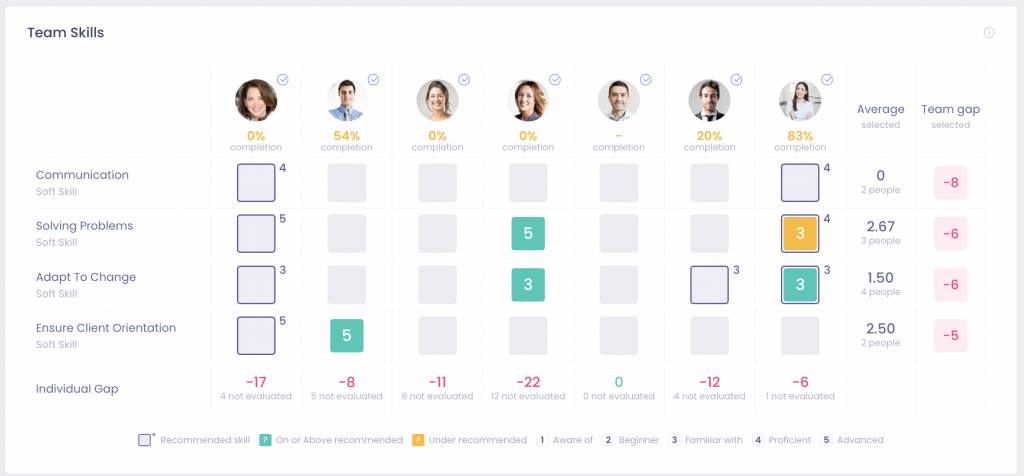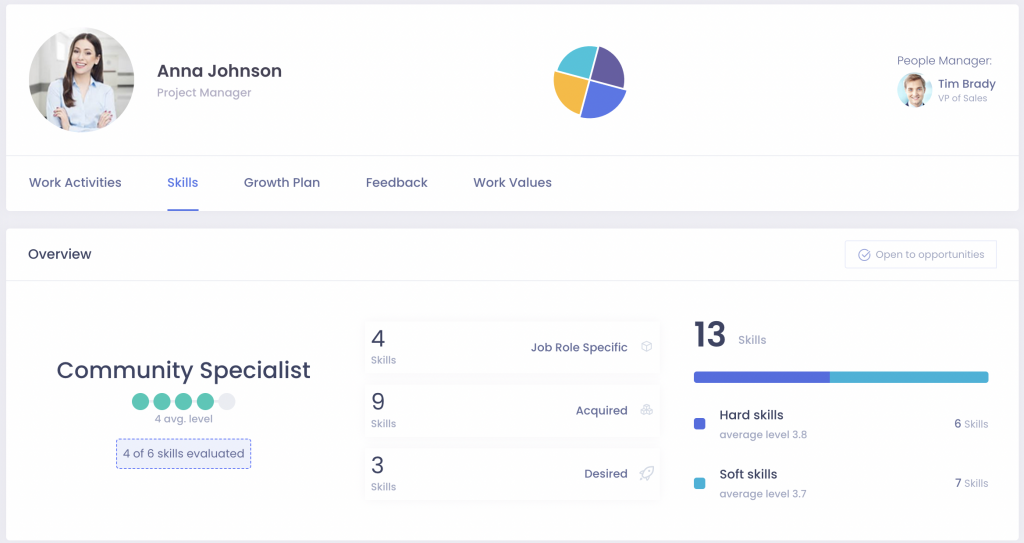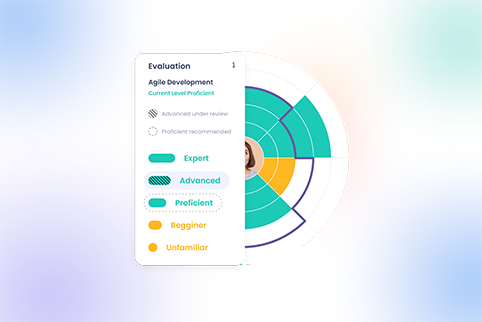
The world has changed and the key to an organization’s success now lies in its ability to adapt, evolve, and leverage the diverse skills and talents of its workforce. This is where the skills matrix comes in!
This strategic tool has the potential to quickly and easily identify the strengths and development areas where employees need improvement — all while supporting better decision-making about targeted employee development, optimizing the allocation of resources, and implementing effective succession planning.
In this article, we’ll explore the crucial role and importance of skills matrices in modern organizations and explain the steps you need to take to reap the benefits of this dynamic tool. Let’s dive right in!
What is a skills matrix?
A skills matrix is a framework that enables HR and people managers to identify and visualize the skills and proficiency levels of employees in relation to their roles or the specific requirements of a given project.
You’ll encounter skills matrices in various easy-to-understand representations, which can be more complex or colorful, such as grids or charts, or as simple as a two-axis table.
The data parameters typically included in a skills matrix are:
- employee name and function
- skills and proficiency level(s)
- skill evaluation status
Why is a skills matrix important?
The importance of a skills matrix stems from its ability to quickly and easily provide data insights on employee skills and (knowledge) gaps. It is especially useful in the larger and more complex skills management process, where it proves to be a valuable tool.
Data from skills matrices can also help HR and decision-makers to:
- Identify missing skills: Skills matrices pinpoint skills that are missing at the individual level, within teams, or company-wide. Knowing exactly what skills are missing and how skill levels are distributed across teams, can help HR and people leaders make informed decisions about external recruiting or filling out open roles with the best internal candidates who are a close fit.
- Track your most valuable and skilled employees: With a skills matrix, you can easily identify and track the development of your most valuable employees, who have the highest level for a particular skill set, that is critical to your organization’s success.
- Improve resource allocation through internal mobility: One of the most powerful benefits of skills matrices is their ability to reveal the right people with the right skills in your teams. This helps assemble on-the-fly teams based on the relevant skills required while encouraging people to make internal moves according to their desires and organizational needs.
- Support succession planning: In an age where the importance of succession planning is still underrated, leaders who embrace skills matrices can proactively identify people who display strong leadership skills and potential and thus ensure a well-rounded pipeline of talent who are ready to step in and ensure business continuity.
- Pinpoint customized employee development actions: The work and impact of L&D specialists in today’s work environment are crucial — especially since organizations already face a severe shortage of key talent, and 90 percent say they will have a meaningful skills gap in the coming years. And, thanks to a regularly updated skills matrix, L&D departments can identify employees who need to expand or level up their skills, acquire new competencies to better perform in their roles, or prepare for new opportunities. These findings can be the starting point for customized development plans, which will help people meet learning objectives faster and align their aspirations with business goals.
What are the benefits of creating a skills matrix?
Perhaps the main benefit witnessed by organizations that use skills matrices is the quick identification of (real-time) skill gaps, which, when not addressed, can bring about consequences ranging from a lack of innovation and competitivity to missed business opportunities and higher turnover rates — all of which increase expenses and limit an organization’s bottom line.
Another advantage worth mentioning is the ability to bring together teams of people who have complementary skill sets and are able to reach high levels of performance while collaborating and learning from each other. This type of dynamic and flexible team concept is becoming increasingly relevant in a world of work where skills and skills-based approaches are replacing traditional role-specific tasks and responsibilities.
Last, but definitely not least, is the simplicity and transparency of a skills matrix. While defining, evaluating, and making sense of skills data can be challenging, the visual representations provided by skills matrices are simple.
Anyone in the organization can make use of them to understand the current status of a particular employee or team and have a clear overview of the skills that need to be improved or areas where performance is limited by talent or knowledge shortages.
How to create a skills matrix
The process of creating an employee skills matrix usually involves:
Identifying the skills you want to evaluate
Both soft and hard skills can be included in a skills matrix, as well as their sub-skills or sub-categories. It all depends on the scope and focus of the matrix and answering questions like:
- Do we address just a small team, a full department, or the entire organization?
- Is it more beneficial or impactful to create separate matrices for soft and hard skills?
- Given the importance of leadership skills, should we address them separately?
To get a better idea, let’s look at how a skills matrix looks in Nestor, our people intelligence platform:

In this example, the matrix is targeting an entire team and the focus is on the soft or human skills each individual requires to perform their role. You can easily notice the simplicity and power of using this type of visual representation.
Colors instantly reveal whether a particular skill is above (green) or under (orange) the recommended level for that position (the number in the top right of each square). The lack of these colors, as is the case for the first employee, indicates they haven’t yet gone through an assessment for that skill.
The summary on the right provides real-time insights into the gaps within the team and can act as the basis for future targeted training and development programs.
Defining skills and proficiency levels
To be effective, a skills matrix needs to use clear definitions for skills and proficiency levels. Additionally, these definitions need to be easy-to-understand and fully transparent — everyone within the organization should be able to access this information.
Once established, skills can then be listed in the individual profile of each worker:

This profile highlights many useful skills data, including both job-specific skills as well as additional abilities that could reveal a particular employee is better suited for a different role or department.
It also highlights the average proficiency level for their skills and points out the competencies that haven’t been evaluated yet.
When it comes to proficiency, at Nestor, we use a 5-level skills grading system:

When defined clearly, these skills levels also help each employee understand where they currently stand and what they need to improve in order to perform better or become eligible for a career move, either vertically or laterally.
Assessing the skills of your employees
When it comes to skill assessment, a wide range of methods and tools are available. And combining them is what often provides the best and most accurate results.
Self-evaluations are important because they encourage employees to be more introspective and learn (or improve) how they assess their own abilities, traits, and work-related performance. This type of evaluation also has the potential to reveal skills that are either hidden or underused and lead to further discussions about exploring the full potential and skill set of that particular employee.
When conducted regularly and focused on skill development not only on productivity, performance reviews can also highlight the current status of an individual’s skill set and the potential for future growth. These review sessions also provide an opportunity to provide constructive feedback and choose the best training programs or learning materials to help the employee continue their development.
Peer or 360 feedback shouldn’t be overlooked either, since managers aren’t always the ones who interact the most with a particular worker. It’s often their peers who do that and who can observe over a period of time someone’s personal qualities and professional expertise.
Of course, companies can also use actual skill tests or simulations to evaluate proficiency levels. Valuable skills insights can also be extracted from training and development records, which show the actual learning outcomes of employees and their engagement in personal growth.
Using data insights and visual representations to identify skill gaps
The final step in creating and making use of an employee skills matrix is to gather all the skills data, identify existing gaps, and determine the urgency and priority of L&D efforts.
Insights from skills matrices can also help HR and hiring managers identify candidates who are a better fit based on the skills and proficiency of current employees. And, in some situations, such insights could also reveal that external hiring is necessary to fill in gaps that cannot be bridged through internal training.
Final thoughts
As we’re entering the age of AI, tools will only become more important and useful, especially in the complex and ever-changing work environment.
By embracing powerful and dynamic assets like skills matrices, organizations can improve the tracking of their skills and proficiency levels and select better training and succession planning initiatives.
Adopting a skills matrix is a strategic and effective way of unlocking the full potential of every employee within the organization and driving greater growth through continuous learning and development — something all companies aspire for.







